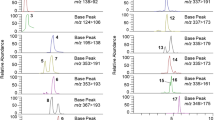Abstract
Organic substances containing nitrogen are widespread throughout the whole of the natural world. Also included amongst these are the methylxanthine derivatives caffeine, theobromine and theophylline. These are very closely related and are to be found in extremely varying contents in different plants. Because of their pharmacological effect, which is fundamentally of a stimulative nature, methylxanthines have been significant since time immemorial as luxury, non-essential foodstuffs and as medication. These substances are often referred to as alkaloids. Theobromine is the major alkaloid in cacao (Theobroma cacao). Caffeine, on the other hand, is only to be found in cacao in very small quantities and theophylline only in trace amounts. Methylxanthines are said to contribute towards the typically bitter taste of cacao. In addition they represent important analytical parameters with regard to the evaluation of the quality of cacao-containing and chocolate products. The amount of methylxanthines in cacao depends on various influencing factors, the most essential ones being processing procedures, genotype, geographical origin and cacao bean weight. By determining the amount of theobromine and caffeine in cacao and/or cacao products, the amount of fat-free dry cacao can also be estimated. There are various methods available for the detection and determination of methylxanthines. UV-spectrophotometric determination and analysis using HPLC have attained major significance here. With regard to human nutrition, cacao and cacao products are the main natural sources of theobromine, but significantly less so with regard to caffeine. The presence of methylxanthines in cacao products leads to that they are sometimes the subject of consumer criticism, particularly because they are considered as luxury foodstuffs. The concluding evaluation of methylxanthines by dieticians and toxicologists reveals that plants that contain methylxanthines have been consumed for as long as can be remembered without having led to damage to health. Scientific research has shown that the consumption of these substances has no consequence whatsoever, as long as consumption is not excessive, which is the case for all foodstuffs. Methylxanthines in cacao products have no negative effects on the health of humans because their amounts in chocolates and other processed foodstuffs containing cacao are so low that they account for only a very small proportion of the whole of the human diet.
Similar content being viewed by others
Author information
Authors and Affiliations
Additional information
Received: 15 November 1996 / Revised version: 22 January 1997
Rights and permissions
About this article
Cite this article
Matissek, R. Evaluation of xanthine derivatives in chocolate – nutritional and chemical aspects. Z Lebensm Unters Forsch 205, 175–184 (1997). https://doi.org/10.1007/s002170050148
Issue Date:
DOI: https://doi.org/10.1007/s002170050148




